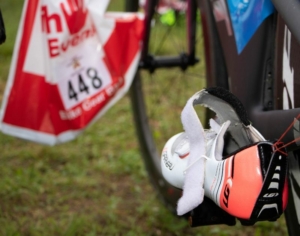Use this guide when preparing your gear bags for Kerrville Tri to make transitions a breeze on race day!
The layout of Kerrville Tri is different from other tri’s due to the two separate transition areas, located two miles apart. It’s important to come prepared with all your gear in the correct place to make your experience easy, and most importantly, fun! Upon receiving your packet, you will be given 3 bags designated for transition on race day, along with your race number stickers and stickers for your gear bags. It’s crucial that you place the designated sticker with your race number on the proper gear bag to make keeping track of your stuff easier. Be ready once you arrive at the race site, and use this step-by-step guide to handle Kerrville Tri transitions with ease.
Step 1
When you’re done checking-in and getting body-marked, place any clothes that you wore to the race site that you do not plan on wearing during the tri in your Green – “Morning Clothes Bag.” Then take your bag to drop it off at the assigned box truck located at T1.
Step 2
After you dominate the swim course, you’ll head into T1 to gear up for the bike portion. Once you change into your bike gear, put your swim gear (ex. goggles, swim cap, towel) in the Red – “Bike Gear Bag” and leave it on the rack where your bike was. We transport all gear from T1 to T2 during the race, so it will be waiting for you in T2 after the race.
Step 3
Prepare your Blue – “Run Gear Bag” with what you plan to wear during the run. This bag should hold all the items you need to transition from the bike to the run portion. Plan ahead because this gear bag needs to be checked into T2 on the day prior to the event! Once you change into your running gear, tie the bag to the rack and head for the run course!
Follow these tips and have your gear bags ready to ensure you have a smooth transition on race day for Kerrville Tri! We’ll see you at the finish line!


